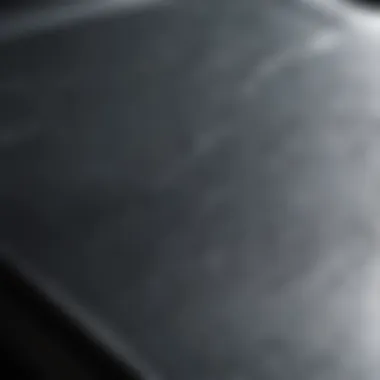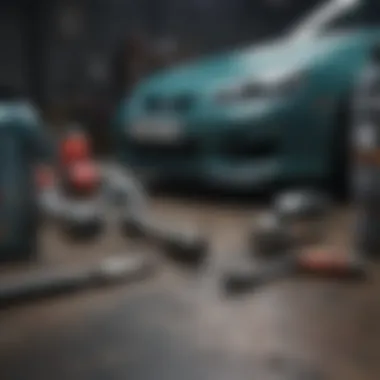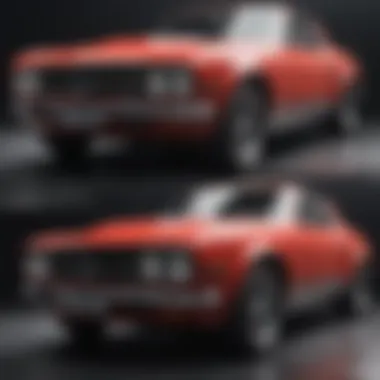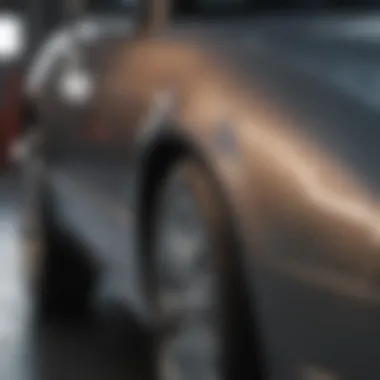Restoring Car Paint: Remove Small Scratches Effectively


Intro
Restoring small scratches on car paint requires an understanding of the materials and methods available. Small imperfections can detract from a vehicle's aesthetic appeal and may lead to more significant issues if left unaddressed. Whether you are a car enthusiast or an everyday driver, knowing how to manage these scratches is essential for maintaining the vehicle's value. This guide will examine safe techniques and products designed for effectively achieving a flawless finish.
Understanding the best practices and tools for car paint restoration is crucial. Effective methods not only improve the vehicle's appearance but can also protect the paint from further damage. This article provides valuable insights, including detailed steps to remove small scratches while explaining the relevance of each method and materials used.
Current Trends
The automotive industry continually evolves, with innovations in paint technology and maintenance tools that significantly impact how enthusiasts and average car owners deal with paint scratches. Understanding the current trends in car maintenance can help consumers make informed choices about restoring their vehicle’s appearance.
Overview of Automotive and Boating Markets
The trend toward enhanced vehicle aesthetics has even flowed into the boating market. Both drivers and boat owners seek options that offer effective solutions to minor imperfections. Advanced paint coatings are now popular in the automotive industry, providing a protective layer against environmental hazards. Many products now featuring ceramic or nano-technology offer outstanding durability and shine.
Key Drivers Influencing Purchases
Several factors drive purchasing decisions in this area:
- Quality of Products: Consumers are increasingly looking for high-quality products that yield better results.
- Environmental Concerns: Eco-friendly options have gained traction, with more buyers favoring sustainable materials.
- Ease of Use: Solutions that simplify the restoration process appeal to both DIY enthusiasts and those with limited experience.
"In today’s market, products that combine effectiveness with user-friendliness are essential."
The popularity of do-it-yourself restoration kits remains high, as many consumers prefer to tackle these jobs themselves rather than seeking professional services.
The next sections will delve into specific methods and products that can help restore car paint and eliminate scratches effectively. Each method will be presented with detailed descriptions, ensuring both beginners and experienced users can understand and apply them successfully.
Prologue to Car Paint Restoration
Car paint restoration is a critical aspect of vehicle maintenance that extends far beyond mere aesthetics. It encompasses the practices and methodologies employed to ensure that a vehicle's exterior retains its shine and luster while also protecting against various forms of damage. Restoring a car's paint can significantly affect its resale value and appearance. Furthermore, understanding the restoration process allows car owners to maintain their vehicles in the best possible condition.
When discussing car paint restoration, one cannot overlook the necessity of addressing small scratches. Small scratches can accumulate over time due to environmental factors, regular use, and even improper cleaning techniques. These seemingly minor imperfections can detract from the overall look of the vehicle, making a new car appear older than it is. As a result, learning to remove these scratches effectively becomes very important for car enthusiasts and average owners alike.
In this article, we will delve into the complexities of restoring car paint. We aim to provide a clear, step-by-step guide that will equip readers with the knowledge required to restore their vehicle's finish. In doing so, we will discuss common types of scratches, the tools and materials needed for effective restoration, and various techniques that can be implemented. Whether one is excited about automotive aesthetics or simply wishes to maintain their investment, understanding the nuances of car paint restoration is invaluable.
Assessing the Damage
Assessing the damage is a critical initial step in the process of restoring your car’s paint. Understanding the type and extent of the damage enables you to choose the most suitable repair method. When you assess scratches and scuffs accurately, you increase the chances of restoring your vehicle’s exterior effectively while minimizing potential further damage.
Identifying Scratches vs. Scuffs


When assessing the damage, it is essential to distinguish between scratches and scuffs. Scratches are deeper abrasions that penetrate the clear coat and may reach the base coat. They often appear as fine lines or grooves that can catch your fingernail. On the other hand, scuffs are usually surface-level marks that do not penetrate the clear coat. Scuffs may appear as dull patches, often caused by contact with other surfaces, such as brushes or rough fabric.
Identifying the difference is crucial for repair techniques. For instance, scratches require more intensive methods such as polishing or using rubbing compound. Scuffs, however, might be removed easily through simple polishing or applying a mild cleaner. Pay attention to the texture and depth, as this will guide your approach.
Evaluating Depth and Severity
Once you have identified the scratches and scuffs, evaluating their depth and severity is the next step. This assessment is important for determining the best method for removal and the products you might need.
Depth can usually be categorized as follows:
- Clear Coat Only: These scratches are shallow, affecting only the clear coat. They can often be treated easily with a polish or rubbing compound.
- Base Coat: If the scratch reaches the base coat, it requires more care. Products such as touch-up paint may be necessary, along with polishing.
- Primer or Metal Exposure: Severe scratches that expose the primer or metal need professional intervention, as they can lead to rust or other serious damage if not treated.
Take time to evaluate scratches in different lighting conditions. This gives better visibility to the extent of any damage. Using your fingers, drag gently over the scratches to feel their depth, as well as observe visually.
\n> "Proper assessment is crucial for effective scratch removal. Neglecting this can lead not only to ineffective results but also further deterioration of your car’s paint."
Through thorough assessment, you ensure a higher likelihood of successful restoration. It sets a foundation for all subsequent steps, whether choosing DIY methods or consulting a professional.
Essential Tools and Materials
The process of restoring car paint often hinges on having the correct tools and materials at your disposal. Using appropriate equipment streamlines the scratch removal process and helps achieve a more polished end result. Without the right items, you may end up causing more harm than good to your vehicle’s paint. Thus, understanding the essential tools and materials will facilitate effective and safe restoration.
Recommended Products for Scratch Removal
When addressing small scratches on car paint, opting for suitable products can significantly impact the outcome. Here are a few categories of products worth considering:
- Rubbing compounds: These are abrasive pastes designed to smooth out surface scratches. Products like Meguiar's Ultimate Compound or 3M Rubbing Compound are commonly used.
- Scratch repair kits: These kits usually contain polish and specific applicators, helping to effectively minimize scratches. Consider brands such as Turtle Wax or Simoniz for good options.
- Polishing pads: Using quality pads can enhance the effects of your rubbing compound. Companies like Chemical Guys and Griot's Garage offer suitable pads that work well with different types of car paint.
- Car waxes or sealants: After corrections, applying a quality wax, such as Collinite or P21S, adds protection to the paint and provides a glossy shine.
When selecting products, always match them to the severity of the scratches and the paint type of your vehicle.
Tools Needed for Effective Restoration
The efficacy of scratch removal does not solely rest on the products used but also on the tools applied in the restoration process. Essential tools include:
- Dual-action polisher: This electric tool offers both rotary and orbital motion, creating efficient results with less risk of damaging the paint. A polisher can significantly reduce the labor involved.
- Application pads: These pads are necessary for applying various compounds and polishes. The right pad can influence how well the product works.
- Microfiber cloths: Soft and absorbent, these cloths are perfect for buffing after applying products without scratching the surface.
- Sandpaper (if needed): For deeper scratches, fine-grit sandpaper might be necessary to level the area. Ensure the grit is appropriate to avoid worsening the damage.
A combination of these tools, along with high-quality products, empowers car owners and enthusiasts alike to restore their paintwork effectively. Thoughtful selection ensures that the restoration process is both efficient and respectful of the vehicle's integrity.
DIY Scratch Removal Techniques
DIY scratch removal techniques are essential for vehicle owners who want to maintain their car’s aesthetic without always depending on professional services. These methods not only save money but also empower car enthusiasts and average owners to take control of the appearance of their cars. Knowing how to handle car scratches can greatly enhance the lifespan of the vehicle's paint. Moreover, mastering these techniques builds confidence in one’s ability to protect and restore their car’s exterior.


Using Rubbing Compound
Using a rubbing compound is a prevalent method among automotive enthusiasts for eliminating small scratches from car paint. This abrasive paste effectively smooths out the surface, restoring it to a more uniform look. A key benefit of this method is the immediate result it provides. When applied correctly, a rubbing compound can significantly reduce the visibility of scratches.
- Process: Start by washing the area to remove dirt. Apply a small amount of compound on a microfiber cloth. Gently buff the area in a circular motion, allowing the compound to do its work. It is crucial not to apply too much pressure, as this may cause further damage. After a thorough buffing, wipe away any residue with a clean cloth.
- Consideration: Always test the compound on an inconspicuous area first to gauge its effect on your car’s specific paint type. Some lighter colors might show more impact than darker colors.
Polishing with a Dual-Action Polisher
Polishing with a dual-action polisher represents a more advanced approach for those serious about car maintenance. This tool utilizes a unique mechanism that combines rotary and orbital movements, which helps in achieving a refined finish while reducing the risk of damage to the paint surface. The use of this method is favored for its efficiency.
- Preparation: Like using a rubbing compound, begin with cleaning the affected area. Select a polishing pad that suits the polisher. Apply a polishing compound to the pad, and set the polisher to a low speed initially to spread the product evenly.
- Technique: Manually guide the polisher over the scratched surface, employing overlapping passes for comprehensive coverage. Gradually increase the speed once the product is adequately spread, ensuring not to linger too long in one spot.
Applying Scratch Repair Kits
Scratch repair kits are designed for ease of use and convenience. These kits usually include various items such as applicators, compounds, and sometimes clear coat solutions. They provide an accessible option for individuals who may not have extensive experience with vehicles.
- Components: Most kits will contain detailed instructions, making them user-friendly. Be cautious to follow these directions precisely. Generally, you start by cleaning the scratched area thoroughly, applying the solution, and smoothing it out with the provided applicator.
- Effectiveness: A well-applied scratch repair kit can effectively fill scratches and protect against further damage. This minimizes the need for immediate professional intervention, allowing for a stopgap that preserves your car until a more comprehensive solution can be achieved.
"DIY methods for scratch removal are not just practical; they allow one to build a personal connection with their vehicle through careful maintenance and restoration."
These DIY techniques can aid in extending your car's appearance and value. Regular practice can lead to improved proficiency, which ensures that small scratches become far less daunting.
Professional Options for Scratch Removal
When it comes to restoring car paint, understanding professional options for scratch removal is crucial. While many vehicle owners may attempt to correct scratches on their own, consulting a professional can offer benefits that DIY methods might not achieve. Professional detailers have specialized training, extensive experience, and access to advanced tools and products that can effectively remove deeper or more stubborn scratches. Recognizing when to seek these services can save time, effort, and sometimes even money if damage becomes worse through inadequate repairs.
Planning to engage professional services should involve some consideration. Factors such as the nature of the scratches, the type of car, and its overall condition all play a role in determining whether a trained detailer is needed.
When to Consult a Professional Detailer
Determining the right moment to bring in a professional detailer typically depends on the severity and depth of the scratches present. If scratches are superficial, DIY techniques such as polishing or using scratch repair kits may suffice. However, deeper scratches that penetrate the clear coat can lead to paint degradation if not handled properly. Signs that you should consider professional help include:
- Visible color underneath the clear coat: This suggests that the scratch may have breached multiple layers of paint.
- Multiple scratches affecting broad areas: If scratches are extensive, they may be better addressed by professionals who can restore the car’s finish uniformly.
- Uncertainty about products and techniques: If you feel unsure about choosing the right product or technique, a detailer can advise you appropriately.
Assessments of your vehicle's paint condition can guide your decision and whether a professional service can address your specific needs effectively.
Benefits of Professional Services
Hiring a professional detailer comes with several advantages that can enhance the final outcome of car paint restoration. First and foremost, expertise is a significant factor. Professional detailers understand the intricacies of various paint types and the best methods to treat them. They are trained to evaluate the damage accurately and proceed accordingly, minimizing the risk of further damage.


Additionally, professional services often use superior products that are not available at general retailers. These specialized substances, combined with advanced equipment, such as dual-action polishers, enable professional detailers to achieve a level of finish that most DIYers will find difficult to replicate.
Moreover, the thoroughness of professional work can be a strong point. They typically clean, polish, and protect the vehicle’s surface as a part of the restoration process. This holistic approach helps to not only remove scratches but also enhance the overall aesthetic and protective layers of the car.
"Investing in professional scratch removal can lead to long-lasting results that preserve your vehicle’s value."
In summary, understanding the importance of professional options in scratch removal equips car owners with better decision-making capabilities. Whether choosing to embark on a DIY project or seeking expert advice, being well informed will make a difference in achieving optimal outcomes for your vehicle's paint restoration.
Preventing Future Scratches
Taking preventive measures against scratches is essential for maintaining the aesthetic appeal and value of your vehicle. Minor scratches can happen from everyday activities. Parking in tight spots, or even during car washes, may lead to unwanted marks on the paint. Understanding how to prevent these scratches can save considerable time and money in the long run.
Regular Maintenance Practices
Regular maintenance is vital for the protection of your car’s finish. Here are some effective maintenance practices:
- Frequent Washing: Keeping your vehicle clean helps avoid the buildup of dirt and contaminants that can scratch the paint when you wash it. Use car-specific products instead of household cleaners, which may be too harsh.
- Quality Waxing: Waxing at least every three months provides a protective layer. It not only makes the car shine but also creates a barrier against minor abrasions from dirt and debris.
- Proper Drying: When drying your car, use a soft microfiber towel. Avoiding rough fabrics will help minimize friction, reducing the chance of leaving scratches.
- Careful Parking: Being mindful about where you park can greatly reduce risks. Try to park away from areas with heavy traffic or where small children play, reducing the chance of accidental scratches.
Protective Coatings and Films
Investing in protective coatings and films can provide an additional level of security against potential scratches. Consider the following options:
- Ceramic Coatings: These advanced solutions bond with the car's paint, providing excellent protection against scratches and UV damage. They create a hydrophobic surface which makes cleaning easier.
- Paint Protection Film: This clear film serves as an effective barrier against scratches and chips. Especially useful for vulnerable areas like the front bumper and hood, it helps shield the paint from road debris.
- Vinyl Wraps: For those looking to change the appearance of their vehicle while providing protection, vinyl wraps can be an innovative solution. Not only will they offer a unique look, but they also guard against light scratches.
Investing in preventative measures for your car’s paint can significantly prolong its lifespan and beauty.
By adhering to these preventative tips, car owners can enjoy a prettier finish while also enhancing the longevity of their vehicle's exterior.
Ending
Restoring car paint, especially when it involves addressing small scratches, forms a vital aspect of vehicle maintenance. This article covers effective strategies for car owners and enthusiasts alike, ensuring that vehicles retain their aesthetic appeal and value. Understanding the nuances of paint restoration is not just beneficial; it is an investment in the long-term upkeep of one's car.
Summarizing Effective Strategies
Several key methods for removing scratches have been examined. Each of these strategies contributes distinctly to paint restoration:
- Rubbing compounds: These are abrasive pastes that polish the paint surface, reducing the visibility of scratches. Using this method requires care to avoid over-polishing, which can damage the clear coat.
- Dual-action polishers: This tool allows for more consistent application of products, creating an even finish. While this option may require an initial investment, the time-saving and quality of results can justify the expense.
- Scratch repair kits: Many kits on the market provide an all-in-one solution for minor scratch issues. They are typically user-friendly and can yield satisfactory results for the average car owner.
By utilizing these techniques, car owners can effectively address superficial paint flaws, improving both the aesthetics and market value of their vehicles.
Emphasizing Routine Care
Regular maintenance cannot be overstated. Establishing a routine care schedule for car paint is essential to prevent scratches and other forms of damage.
- Washing and drying: Gentle, regular washing with appropriate materials will reduce the chance of dirt and debris scratching the paint surface. Utilizing microfibre towels for drying can also minimize risks.
- Sealants and waxes: Monthly application of protective coats will bolster the paint's defenses against environmental factors like UV rays, which can lead to fading and degradation over time.
- Inspection: Periodically inspecting the vehicle for new scratches allows for early intervention. Catching minor issues before they escalate can save time and resources in the long run.







